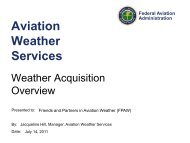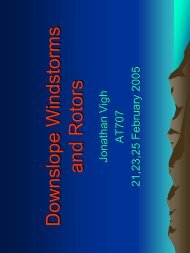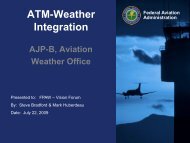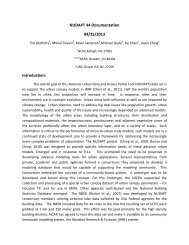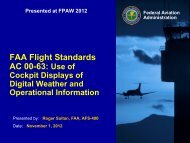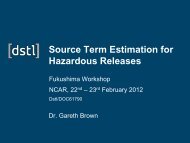Demonstration of Gridded Bias Correction
Demonstration of Gridded Bias Correction
Demonstration of Gridded Bias Correction
You also want an ePaper? Increase the reach of your titles
YUMPU automatically turns print PDFs into web optimized ePapers that Google loves.
<strong>Demonstration</strong> <strong>of</strong> <strong>Gridded</strong><br />
<strong>Bias</strong> <strong>Correction</strong><br />
Daran Rife<br />
National Center for Atmospheric Research<br />
24 February 2009<br />
1
Outline<br />
• What is the gridded bias correction system and<br />
how does it work?<br />
• Examples <strong>of</strong> bias corrected forecasts.<br />
• Discussion: How should bias corrected forecasts<br />
be displayed?<br />
2
Why implement a statistical correction?<br />
Real world<br />
Model representation<br />
3
Why implement a statistical correction?<br />
WSMR 6-h MM5 forecast errors during 2005,<br />
valid 1800 UTC<br />
2-m-AGL temperature<br />
10-m-AGL wind speed<br />
4
Why not use a traditional MOS<br />
approach?<br />
5
One alternative<br />
Running-mean bias correction<br />
6
Schematic <strong>of</strong> running-mean bias<br />
correction<br />
<strong>Bias</strong> correction computed as function <strong>of</strong><br />
station location and time <strong>of</strong> day<br />
7
Estimating and removing errors from<br />
the full model grid<br />
Motivation by analogy: Curve fitting<br />
8
Estimating forecast<br />
biases between and<br />
away from station<br />
locations<br />
9
How does the gridded bias correction<br />
work?<br />
• STEP 1: Measure forecast bias at<br />
observation locations.<br />
• STEP 2: Calculate coefficients <strong>of</strong> regression<br />
that describe the linear relationship<br />
between the running-mean forecast<br />
variables at the obs locations, and those at<br />
every point on the grid.<br />
10
Calculating coefficients <strong>of</strong> regression<br />
11
How does the gridded bias correction<br />
work?<br />
• STEP 1: Measure forecast bias at observation<br />
locations.<br />
• STEP 2: Calculate coefficients <strong>of</strong> regression<br />
that describe the linear relationship between<br />
the running-mean forecast variables at the obs<br />
locations, and those at every point on the grid.<br />
• STEP 3: Subtract bias from “raw” forecast to<br />
obtain a correction at each obs location.<br />
• STEP 4: Use regression coefficients to “map”<br />
to corrections (at obs sites) onto the full grid.<br />
12
Mapping corrections onto grid<br />
Mapping correction onto<br />
grid from bias measured<br />
at single location (S32).<br />
13
Diurnal evolution <strong>of</strong><br />
forecast bias<br />
29 June 2005<br />
14
Improvements realized through bias<br />
correction<br />
Use BC with CAUTION<br />
during regime changes!<br />
MM5 2-m-AGL temperature forecasts WSMR grid 3.<br />
15
<strong>Bias</strong> correction provided for:<br />
• 2-m-AGL temperature<br />
• 2-m-AGL dew point temperature<br />
• 2-m-AGL relative humidity<br />
• 10-m-AGL wind direction<br />
• 10-m-AGL wind speed<br />
16
Displaying bias corrected forecasts<br />
Model forecast table<br />
17
Displaying bias corrected forecasts<br />
<strong>Bias</strong> corrected<br />
BC T2 (°C)<br />
BC Td (°C)<br />
BC RH (%)<br />
BC Wspd10 (m/s)<br />
18
Displaying bias corrected forecasts<br />
19
Displaying bias corrected forecasts<br />
Animation: Uncorrected WRF RTFDDA<br />
Animation: <strong>Bias</strong> corrected WRF RTFDDA<br />
20
Displaying bias corrected forecasts<br />
Animation: Uncorrected WRF RTFDDA<br />
Animation: <strong>Bias</strong> estimate WRF RTFDDA<br />
21
Choosing the bias sampling period<br />
WSMR MM5 grid-3 2-m-AGL temp forecasts 2005<br />
23





